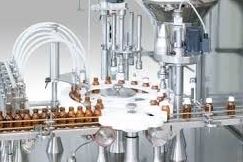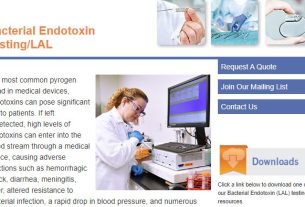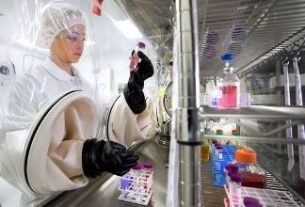Page Contents
1 PURPOSE
To ensure control over viable and non-viable count in the clean area.
2 SCOPE
This procedure is applicable for a different part of all manufacturing areas of the sterile dosage form. (Injection section)
3 RESPONSIBILITY
Microbiologist, Quality Control Manager, Section Supervisor, Production manager
4 Equipment/APPARATUS
i) Nutrient Agar
ii) Tryptone Soya Agar
iii) Autoclave, Incubators
iv) Petri dishes
v) Non-Viable Laser Air Particle Counter {Particle counter(Light House)}
vi) Anemometer
vii) Sterile Swabs, Normal Saline 0.9% NaCl
viii) Oven
5 PROCEDURE
5.1 Microbiological Monitoring
5.1.1 Preparation of culture Media: Dissolve 20 grams of the Tryptone Soya Agar growth media in 500ml of purified water, and 14 gm nutrient agar in 500ml purified water. Mix thoroughly while gently heating, and sterilize by autoclaving at 121ºC at 15lbs pressure for 30 minutes. After autoclaving cool the medium. Pour the media in sterilized Petri plates
5.1.2 Expose Nutrient Agar plates and Tryptone Soya agar plate in the sterile area as per the annexure-I
5.1.3 Distribution of Petri dishes in the sterile area
- Injectable Manufacturing Room 03
- Door side
- Window side
- Vessel side
- Injectable Filling 05
- Door side
- Central Table
- Working Station
- Window side
- The injectable line starting point
- Buffer Room 01 01 Each
5.1.4 Took air sample (Min 50L) through Air sampler by using Nutrient Agar plates and Tryptone Soya Agar plate as per the annexure-I
5.1.5 Time Specified: Expose settle plates for 4 hours
5.1.6 Incubate the Nutrient Agar Plates at 30-35ºC and Tryptone soya Agar plates at 20-25ºC for 5 days or unless a reliable count is obtained in a shorter time (24-48 hours)
5.1.7 Record the result as per annexure-I
5.1.8 FREQUENCY
5.1.8.1 Daily and after every maintenance job
5.2 SWAB TEST
5.2.1 Swab test is applicable to sterile surfaces and equipment present in clean rooms. Micro-organisms are spread by hands, coughing, and sneezing from the human respiratory tract and dust particles are circulated by air and the earth’s surface.
5.2.2 Preparation of Culture Media:
5.2.2.1 Dissolve 20 grams of the Tryptone Soya agar growth media in 500ml of purified water and 14 grams nutrient agar in 500ml purified water. Mix thoroughly while gently heating and sterilize by autoclaving at 121ºC at 15lb pressure for 30 minutes. After autoclaving cool the medium. Pour the media in sterilized Petri plates
5.2.3 Procedure
5.2.3.1 Aseptically add 5ml sterile (autoclave) normal saline solution (0.9% NaCl) in a tube containing sterile swab (available from market). Then take the swab out of the tube and swab the area 25cm². Put the swab back into the tube. Gently shake the tube and pour this solution in a petri dish and pour the sterile media in a petri dish. After solidification incubate the Nutrient Agar Plates at 30-35ºC and Tryptone Soya Agar plates at 20-25ºC for 5 days or unless a reliable count is obtained in a shorter time(24-48 hours)
5.2.4 Exposing Surfaces
- Machines
- Nozzles
- Laminar Flow Hood Walls
- Vessel Mouth
- Empty Bottles
- Sterile Vials
- Sterile rubber stoppers
- Walls and tables of different sections of the production area
- Spoons
- Transfer pipes
- Sterile uniform
- Filtration Assembly
- Floor
5.2.5 Specifications
For each grade controlled areas or clean rooms, microbial limits are given below.
Table: Limits For Microbial Contamination (cfu/25cm²)
| Sr. No | Grade/ Class | At rest (CFU/25cm²) | Operational (CFU /25cm²) |
| 1 | A | ˂1 | NMT 3 |
| 2 | B | ˂1 | 5 |
| 3 | C | 5 | 25 |
| 4 | D | 25 | 50 |
The limits are Bacterial count. Mold or fungal count should be considered as zero
5.2.5 Record the result as per annexure-I
5.2.5 FREQUENCY
5.2.6.1 Daily and after every maintenance job.
5.3 FINGER TEST
5.3.1 Microorganisms are spread by hands, coughing, and sneezing from the human respiratory tract and dust particles are circulated by air and the earth surface. This method is for the observation of microbial load in hands.
5.3.2 Record the result as per annexure-I
5.3.3 FREQUENCY
5.3.3.1 Daily and after every maintenance job
5.4 Non-viable Particle count/airborne particles
5.4.1 Charge and check the non-viable particle counter for its proper working.
5.4.2 Wipe the non-viable particle counter and its probe with duster dipped in 70% filtered IPA
5.4.3 Place the equipment in SS-tray already wiped with filtered IPA
5.4.4 Transfer the SS-Tray to the area to be tested and place the SS-Tray in pass box through under UV-light for at least 20-30 minutes
5.4.5 Take the equipment out of SS-tray and again wipe with duster dipped in 70% filtered IPA
5.4.6 Record the name of the operator(s) working in the clean air device being tested and their activity at the time of testing.
5.4.7 Position the probe isokinetically in relation to the airflow (facing the airflow). The particle counter should be positioned at 1 foot above the working level.
5.4.8 Run the particle counter. Observe the first count to ensure the particle counter is operating correctly and discard the reading.
5.4.9 Take the consecutive three reading for 0.5µm and 5µm particles by moving the particle counter in the entire area so that all area is sampled for non-viable particle count. Sampling time must be 1 minute for each reading and sampling volume should be 27L or 1ft³
5.4.10 If there are more than one HEPA filters in an LFH, take the separate readings for each filter as described above
5.4.11 Take the average of readings for both particles.
5.4.12 Record the result as per annexure-annexure-II
5.4.13 FREQUENCY
5.4.13.1 Daily and after every maintenance job.
5.5 ASEPTIC AREA VALIDATION
The controlled areas should follow ANNEXURE III AS PER ASEPTIC AREA VALIDATION SOP.
Annexure -i
| Sr # | Location | Class | Air sample / M3 Air | Settling Plates / 4 hr. exposure | Surface Viables
(except floors) / plate |
Surface Viables
(floors) / plate |
| 1 | Buffer 1 | C | ||||
| 2 | Buffer 2 | C | ||||
| 3 | Buffer 3 | B | ||||
| 4 | Airlock Buffer | B | ||||
| 5 | Inj Mfg room | B | ||||
| 6 | Inj filling & sealing room | B | ||||
| 7 | Inj filling line (under (LFH ) | A | ||||
| 8 | Cooling Zone | B | ||||
| 9 | Vial Washing Area | C |
ANNEXURE II
| Sr # | Location | Class |
PARTICLE SIZE |
Particle number m3 |
|
| 1 | Buffer 1 | C |
0.5μ |
350,000* 3,500,000** |
|
| 5.0 μ |
2,000* 20,000** |
||||
| 2 | Buffer 2 | C |
0.5μ |
350,000* 3,500,000** |
|
| 5.0 μ |
2,000* 20,000** |
||||
| 3 | Buffer 3 |
B |
0.5μ |
3,500*
350,000** |
|
| 5.0 μ |
0* 2,000** |
||||
| 4 | Airlock Buffer | B |
0.5μ |
3,500*
350,000** |
|
| 5.0 μ |
0* 2,000** |
||||
| 5 | Inj Mfg room | B |
0.5μ |
3,500*
350,000** |
|
| 5.0 μ |
0* 2,000** |
||||
| 6 |
Inj filling & sealing room |
B |
0.5μ |
3,500*
350,000** |
|
| 5.0 μ |
0* 2,000** |
||||
| 7 | Inj filling line (under (LFH ) | A |
0.5μ |
3,500*
3,500** |
|
| 5.0 μ | 0*
0** |
||||
| 8 |
Cooling zone |
B |
0.5μ |
3,500*
350,000** |
|
| 5.0 μ |
0* 2,000** |
||||
| 9 | Vial Wasing Area | C |
0.5μ |
350,000* 3,500,000** |
|
| 5.0 μ |
2,000* 20,000** |
ANNEXURE III
ASEPTIC AREA VALIDATION REPORT
| Tests | Acceptance Criteria |
| Air Flow Velocity. Volume and Uniformity Tests | _The average airflow velocity, or the average or total airflow volume, for, The cleanroom or clean zone should be within ±5% of the value specified for the cleanroom or clean zone, or within other Standardized tolerance limits.
The relative standard deviation should not exceed 15% |
| HEPA filter/Leak test(DOP) | HEPA filters 99.99%.P: Aerosol penetration is lower or equal to 0.01% of the upcoming concentration
HEPA filters 99.,97\%: Aerosol penetration is lower or equal to 0.03% of the upcoming concentration _HEPA filters 95%: aerosol penetration is lower or equal to 5% of the upstream concentration |
| Temperature Control | The system shall be capable of maintaining the temperature as per designed standards all year round, Temperature should be U.S Federal standards 209E:22±2.8ºC |
| Humidity Control Test | The relative humidity at each grid point shall be equal to specified levels and therefore tolerance limits indicated on each recording form, the system is requires
Requirement: U.S Federal Standard 209 E:30-45%0 to relative humidity |
| Airflow and Uniformity Test | Average measured clean air velocity shall be according to the designed standard at 6 in. downstream from the filter face. Velocity difference within the same plenum should be no more than 25% |
| Air Pressure Control Test | _Pressure differentials should be as indicated in the design conditions at all times under static conditions. _Pressure differentials should be maintained as indicated the design conditions under standard simulated operating conditions
_Pressure differentials should be above 0.02 in the primary environment when stress conditions occur. _The system will not be accepted if, at any time during normal dynamic, static, or stress conditions, the pressure in the primary environments become less than zero or negative. |
| Airborne Particle Count Test | AS PER ANNEXURE-II |
| Induction Leak Test | No construction joint leaks or intrusion through open doors should exceed 0.1% of the measured external concentration. |
| Air Flows Patterns Test
|
If the results of the test are unsatisfactory, the laminar flow system cannot be validated and the rest of the validation tests should not be carried out until a satisfactory operation has been reached. Otherwise, the system is valid and can be certified
Should corrective changes be necessary, the changes are made and recorded _A turbulent airflow should not be present at each area location. |
| Recovery Time | The recovery time should be not more than 2min. |
| Particle Dispersion Test
|
The degree to which dispersion away from the smoke source is confined and the regulatory of the patter (an indication of directional drift in one direction) is a matter of the configuration of the line. It is recommended that dispersion should not extend beyond 2ft rapidly from the point of smoke, i.e at 2 ft from the generation point, the particle count should be less than 100 per cubic foot of the 0.5µm size and larger. |
| Airborn Microbial Test | AS PER ANNEXURE- |
| Surface Bio-burden Test | AS PER ANNEXURE-I
|
6. QUALITY RECORD(s)/Form(s)
| Required Record | Form Reference No. |
| Inj section viable area monitoring report
(colony Forming units count Method) |
|
| Inj section nonviable area monitoring report
(Particle count Method) |
|
| Aseptic Area Validation Report |


